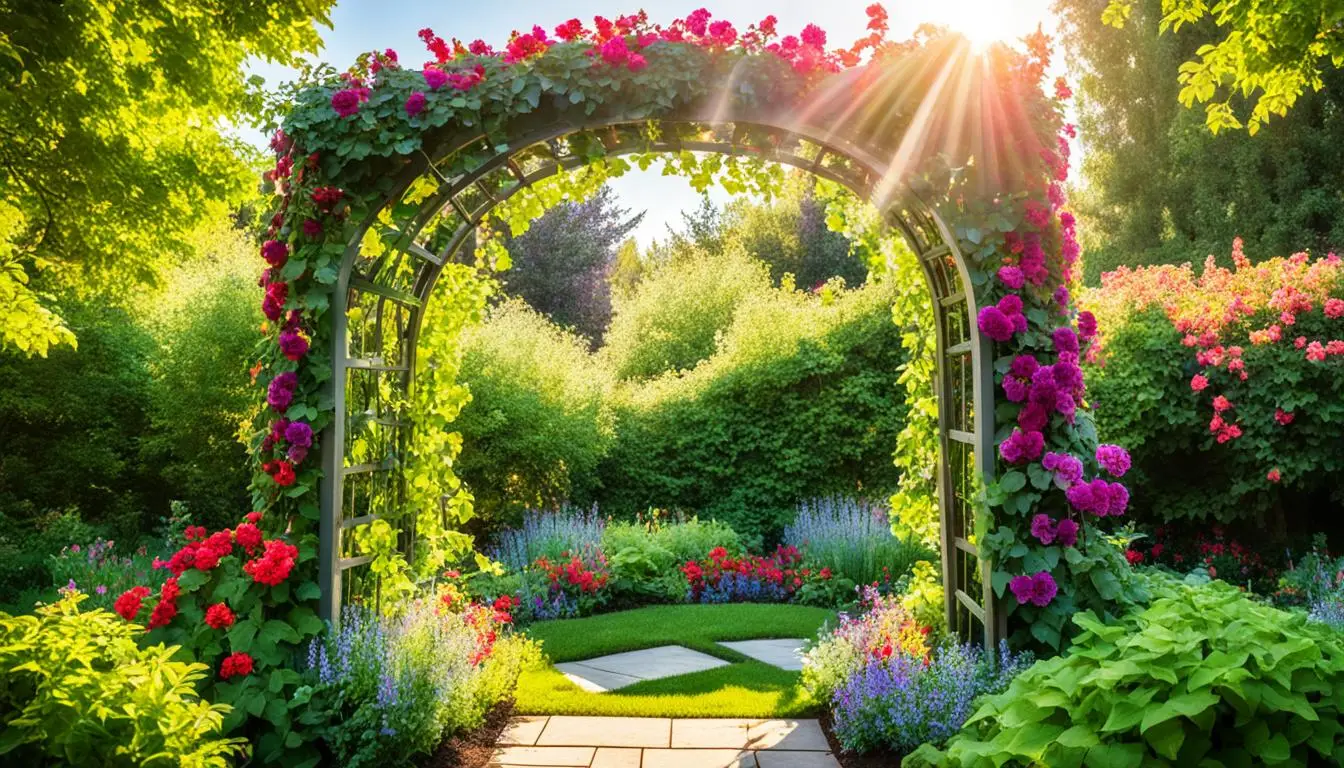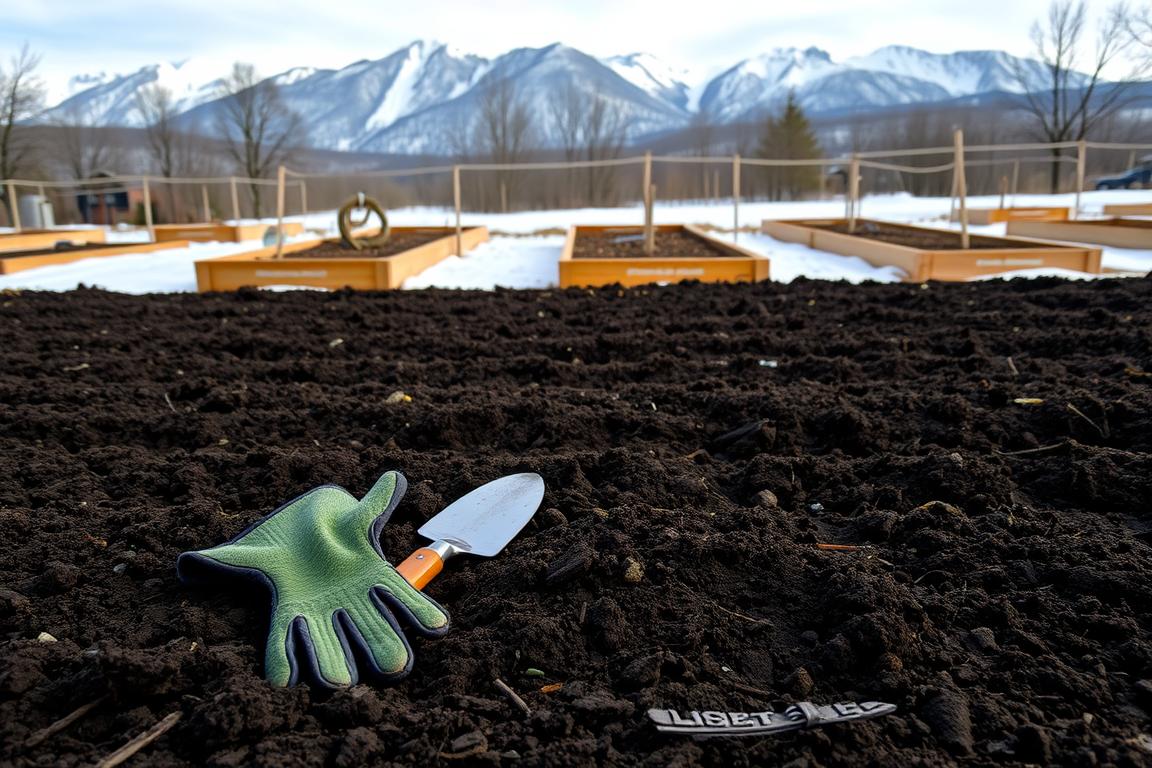Add beauty to your yard with lovely garden trellises for climbing plants. You can choose from traditional wood and metal to upcycled items. Whether you’re a pro or new to vertical gardening, creating these trellises is simple. They can make your garden look like a green paradise with outdoor decor.
Picture a charming cottage garden arch wrapped in roses, or a lattice fence trellis with morning glories hanging down. Maybe you like the idea of a rugged trellis made from grapevine branches, or a vintage ladder turned trellis for beautiful climbing plants. These examples show how creative DIY trellis ideas can really change your yard.
Key Takeaways
- Elevate your outdoor space with stunning garden trellises
- Endless DIY trellis options to suit any style or space
- Repurposed materials can add unique character to your trellis
- Trellises support the growth of lush, climbing plants
- Easy-to-build projects can transform your backyard into a verdant oasis
Introduction to DIY Garden Trellises
A garden trellis makes any garden look better and work better. It holds up pretty flowers or tasty fruits. It also lets you grow more in small spots, like little gardens or raised beds. Plus, trellises can make your garden look gorgeous.
You can turn them into arches, tunnels, or even gates. They’re great for privacy screens or just adding beauty to a boring wall or fence. Trellises work well for lots of plants that climb, from roses to beans.
The Benefits of Garden Trellises
Vertical gardening saves space because it grows plants up instead of out. This is perfect for places like small yards, patios, or balconies. Trellises help climbing plants produce lots of fruits or flowers, even if you don’t have much room.
Types of Climbing Plants Suitable for Trellises
The best plants for trellises are things like roses, clematis, and morning glories. Also sweet peas, beans, and cucumbers. They love to climb and need the trellis to support them. Mixing these plants together can turn any spot into a beautiful garden space.
DIY Garden Trellis
Building your garden trellis is easy and fun. It helps your garden look better and plants grow well. You can use it for plants that grow upwards, like vines, cucumbers, or tomatoes. It gives your garden a pretty vertical look.
Materials Needed for a Simple DIY Trellis
You only need a few things for a basic DIY trellis. Here’s what you’ll need:
- Wood for the frame (like lumber or PVC pipes)
- Bamboo or metal rods for support
- Wire, twine, or other things to hold it together
- Screws, nails, or more to put it all together
The materials for your DIY trellis depend on its size and style. You can pick from wooden posts, metal T-posts, or natural pieces like bamboo.
Step-by-Step Instructions for Building a Trellis
First, get your materials ready. Building a simple DIY trellis has a few steps:
- Decide on a design for your trellis
- Measure and cut the pieces you need
- Put the frame together by drilling, hammering, and attaching pieces
- Make sure the trellis stands straight and is firmly placed
Creating your trellis can take a weekend if you follow easy instructions. Be creative and detailed. This way, you’ll make a beautiful trellis that helps your garden and looks great, too.

Creative DIY Garden Trellis Ideas
Gardeners often find new uses for everyday things to make unique trellises. They may use items like old windows, vintage ladders, or recycled fences. Even branches and twine can become repurposed materials for trellises. Such materials not only support climbing plants but also make the garden look special.
Repurposed Materials for Unique Trellises
Things like old windows, ladders, and fences can turn into unique trellis designs. This creativity makes the garden stand out. Using natural items such as branches and twine also creates garden decor that fits well with nature.
Decorative Trellis Designs
There are trellises that do more than just support plants. They can also look beautiful. Options include honeycomb shapes, arches, and obelisks. By adding color or stain to wood or metal, these trellises can match the garden decor.

Vertical Gardening with Trellises
Trellises are key for vertical gardening. They help gardeners use space well by growing plants up, not out. This is great for small areas like yards, patios, or balconies. Trellises are perfect for climbing plants and vining vegetables, leading to big harvests in tiny spots.
Space-Saving Benefits of Vertical Gardening
Trellis gardening saves a lot of room. Rather than plants spreading on the ground, trellises let climbing plants reach up. This opens space for more plants or stuff. It’s a top choice for small outdoor areas, like in cities or tiny yards and balconies.
Planting and Training Climbing Plants on Trellises
Choosing the right climbing plants for a trellis is key. It’s also vital to help these plants grow the right way. You might need to gently guide the vines up, secure them in place, and keep their shape with pruning. A little care turns trellises into perfect spots for plants and a lovely garden view.
Maintenance and Care for Garden Trellises
To keep your DIY garden trellises looking nice and working well for your climbing plants, you need to do some regular care. This means making sure any loose parts are tightened, and the wood or metal is treated to avoid damage. You should also check for wear and tear often. Fixing or replacing broken parts helps your trellises last longer.
Watching over your garden trellises is important. Look for any damage regularly, like wood that’s cracking or metal that’s rusting. Also, make sure the fasteners are staying tight. Adding a weather-resistant sealant or paint will protect the trellises from the weather. This can help them last even longer.
Taking good care of your garden trellises means your climbing plants will have a great place to grow. Well-maintained trellises offer strong support. This allows your plants to flourish, making your outdoor area look beautiful for a long time.
Conclusion
DIY trellises are a smart and stylish way to enhance your yard. They lift your plants up and make your garden area look full and beautiful. You can make a trellis out of many different materials, such as wood or metal. Or you can go for something unique by using items you already have. No matter what you choose, making your own trellis is a fun and rewarding DIY project. It brings character, usefulness, and eye-catching features to your garden.
Building a trellis takes some planning and the right stuff, but it’s totally worth it. A well-made trellis not only makes your garden look good, it helps it grow better too. It’s particularly great if you’re short on space. Plus, it’s a cool way to make your outdoor area stand out. Adding a home-built trellis to your garden is simple and satisfying. It turns your yard into a space you’ll love even more. So, whether you’re a pro gardener or just starting, a trellis is a great project to do.
FAQ
What are some popular climbing plants for garden trellises?
Many love to plant roses, clematis, and morning glories on trellises. Sweet peas, beans, and cucumbers also thrive. Don’t forget indeterminate tomatoes too.
What materials are commonly used to build a DIY garden trellis?
DIY garden trellises can be made from lumber, PVC pipes, or metal T-posts. You can also use natural items like branches and bamboo.
How do you build a simple DIY garden trellis?
First, pick a design. Then, cut your chosen materials to size. Next, put together the frame. Finally, fix your trellis where you want it.
What are some creative DIY garden trellis ideas?
People are finding fun ways to build trellises. Try using old windows, ladders, or fencing for a unique touch. Even branches and twine can work wonders.
How do trellises benefit vertical gardening?
Trellises help with vertical gardening. They let plants grow up instead of out. This is great for saving space in small areas.
How do you maintain and care for garden trellises?
Keep trellises in good shape by checking for loose parts. Treat wood or metal to protect it from the elements. Also, replace anything that’s broken or too worn.






